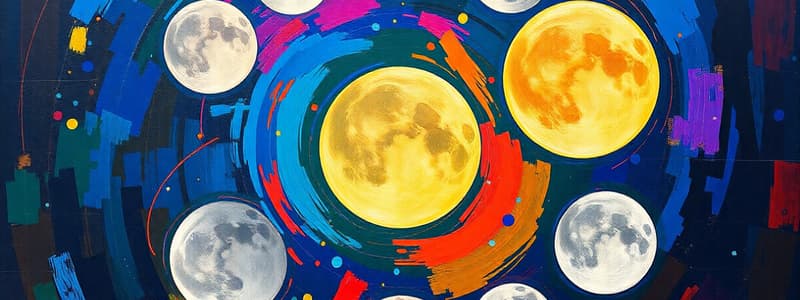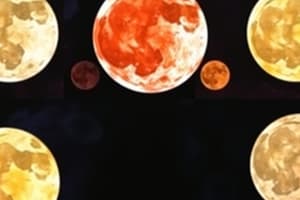Podcast
Questions and Answers
What is the composition of the Moon primarily made up of?
What is the composition of the Moon primarily made up of?
- An iron-rich core, mantle, and crust containing minerals (correct)
- Rocky materials with organic compounds
- Helium and hydrogen gases
- Liquid water and sediment layers
What significant event occurred on July 20, 1969?
What significant event occurred on July 20, 1969?
- The first photograph of the Moon was taken
- The Moon experienced a meteor shower
- The Moon's orbit was calculated
- Apollo 11 landed on the Moon (correct)
What type of geological features are primarily visible on the Moon's surface?
What type of geological features are primarily visible on the Moon's surface?
- Rivers and oceans
- Volcanoes and mountains
- Lakes and forests
- Craters formed by meteoroids, comets, and asteroids (correct)
Which of the following statements about the Moon's phases is true?
Which of the following statements about the Moon's phases is true?
Which is the largest crater on the Moon?
Which is the largest crater on the Moon?
Flashcards
Moon's age
Moon's age
4.5 billion years old
Moon's diameter
Moon's diameter
3476 km
Moon's surface material
Moon's surface material
Dust and rocky debris
Moon's orbit distance
Moon's orbit distance
Signup and view all the flashcards
Tidal Processes
Tidal Processes
Signup and view all the flashcards
Study Notes
Moon Formation and Composition
- Formed 4.5 billion years ago
- Fifth largest moon, with a diameter of 3,476 km
- Composed of an iron-rich core, mantle, and crust containing minerals
- Surface is entirely covered in dust and rocky debris
- Contains impact craters formed by meteoroids, comets, and asteroids
- South Pole-Aitken Basin is the largest crater
- Orbits Earth at a distance of 384,000 km
Moon's Rotation and Revolution
- Rotates at the same rate it revolves around Earth
- Same side of the moon always faces Earth
Moon Phases
- Eight distinct phases are visible
- Includes new moon, waxing crescent, first quarter, waxing gibbous, full moon, waning gibbous, last quarter, and waning crescent
- 20 July 1969 - Apollo 11 landed on the moon
Studying That Suits You
Use AI to generate personalized quizzes and flashcards to suit your learning preferences.
Description
Explore the fascinating aspects of the Moon, including its formation, composition, and phases. Learn about its rotation, revolution around Earth, and the historical significance of the Apollo 11 landing. This quiz delves into the unique features and characteristics of our planet's natural satellite.




